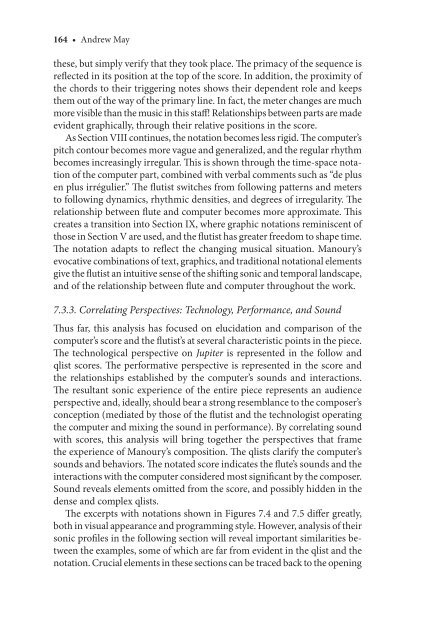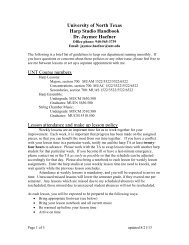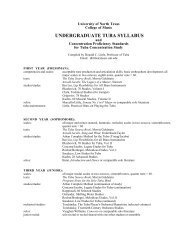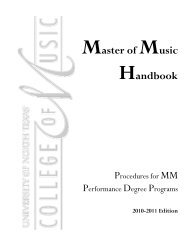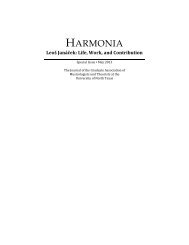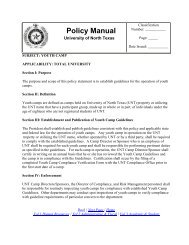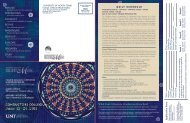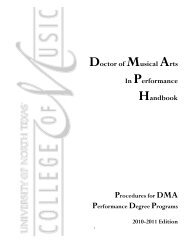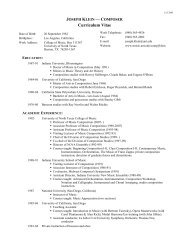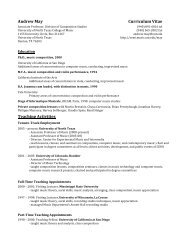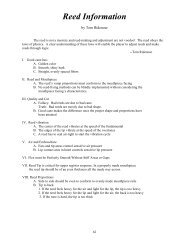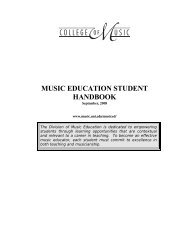7 Philippe Manoury's Jupiter1
7 Philippe Manoury's Jupiter1
7 Philippe Manoury's Jupiter1
You also want an ePaper? Increase the reach of your titles
YUMPU automatically turns print PDFs into web optimized ePapers that Google loves.
164 • Andrew May<br />
these, but simply verify that they took place. Th e primacy of the sequence is<br />
refl ected in its position at the top of the score. In addition, the proximity of<br />
the chords to their triggering notes shows their dependent role and keeps<br />
them out of the way of the primary line. In fact, the meter changes are much<br />
more visible than the music in this staff ! Relationships between parts are made<br />
evident graphically, through their relative positions in the score.<br />
As Section VIII continues, the notation becomes less rigid. Th e computer’s<br />
pitch contour becomes more vague and generalized, and the regular rhythm<br />
becomes increasingly irregular. Th is is shown through the time-space notation<br />
of the computer part, combined with verbal comments such as “de plus<br />
en plus irrégulier.” Th e fl utist switches from following patterns and meters<br />
to following dynamics, rhythmic densities, and degrees of irregularity. Th e<br />
relationship between fl ute and computer becomes more approximate. Th is<br />
creates a transition into Section IX, where graphic notations reminiscent of<br />
those in Section V are used, and the fl utist has greater freedom to shape time.<br />
Th e notation adapts to refl ect the changing musical situation. Manoury’s<br />
evocative combinations of text, graphics, and traditional notational elements<br />
give the fl utist an intuitive sense of the shift ing sonic and temporal landscape,<br />
and of the relationship between fl ute and computer throughout the work.<br />
7.3.3. Correlating Perspectives: Technology, Performance, and Sound<br />
Th us far, this analysis has focused on elucidation and comparison of the<br />
computer’s score and the fl utist’s at several characteristic points in the piece.<br />
Th e technological perspective on Jupiter is represented in the follow and<br />
qlist scores. Th e performative perspective is represented in the score and<br />
the relationships established by the computer’s sounds and interactions.<br />
Th e resultant sonic experience of the entire piece represents an audience<br />
perspective and, ideally, should bear a strong resemblance to the composer’s<br />
conception (mediated by those of the fl utist and the technologist operating<br />
the computer and mixing the sound in performance). By correlating sound<br />
with scores, this analysis will bring together the perspectives that frame<br />
the experience of Manoury’s composition. Th e qlists clarify the computer’s<br />
sounds and behaviors. Th e notated score indicates the fl ute’s sounds and the<br />
interactions with the computer considered most signifi cant by the composer.<br />
Sound reveals elements omitted from the score, and possibly hidden in the<br />
dense and complex qlists.<br />
Th e excerpts with notations shown in Figures 7.4 and 7.5 diff er greatly,<br />
both in visual appearance and programming style. However, analysis of their<br />
sonic profi les in the following section will reveal important similarities between<br />
the examples, some of which are far from evident in the qlist and the<br />
notation. Crucial elements in these sections can be traced back to the opening<br />
Simoni_RT76294_C007.indd 164 9/22/2005 11:19:22 AM


